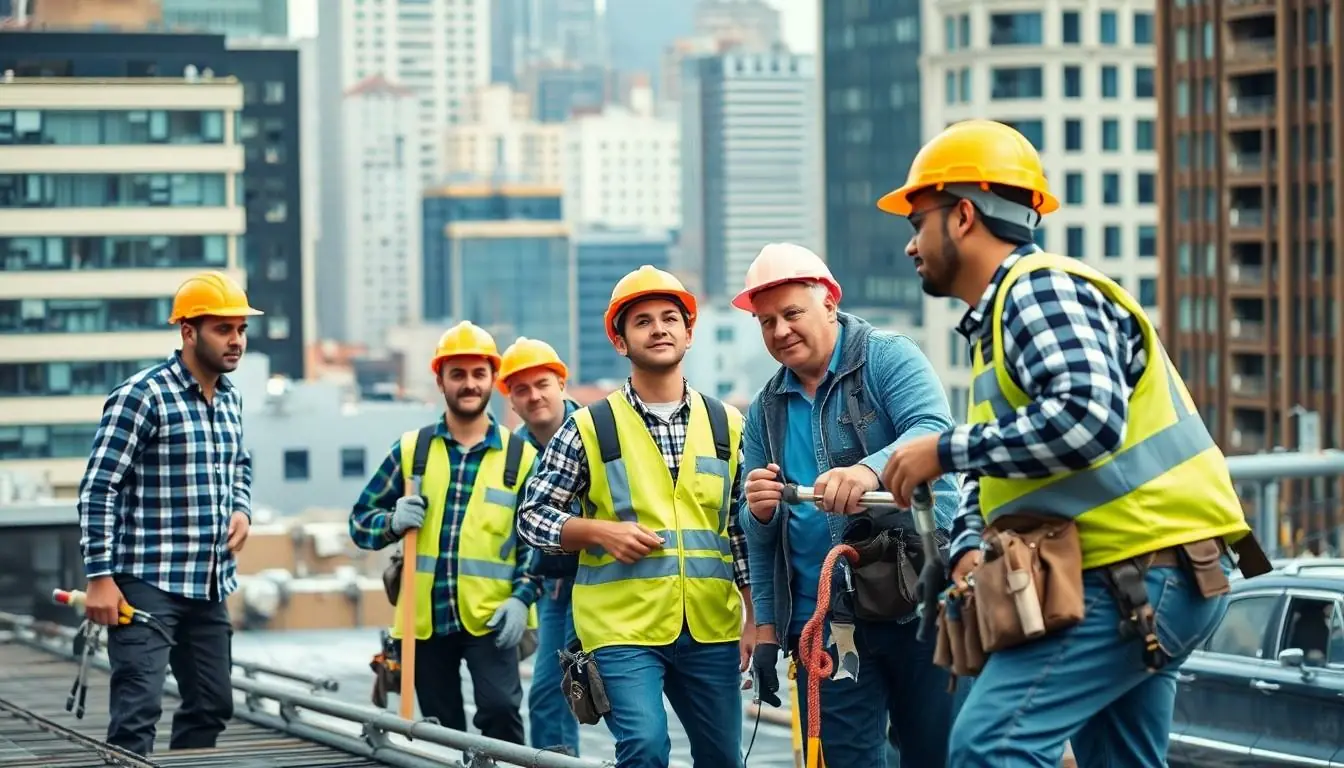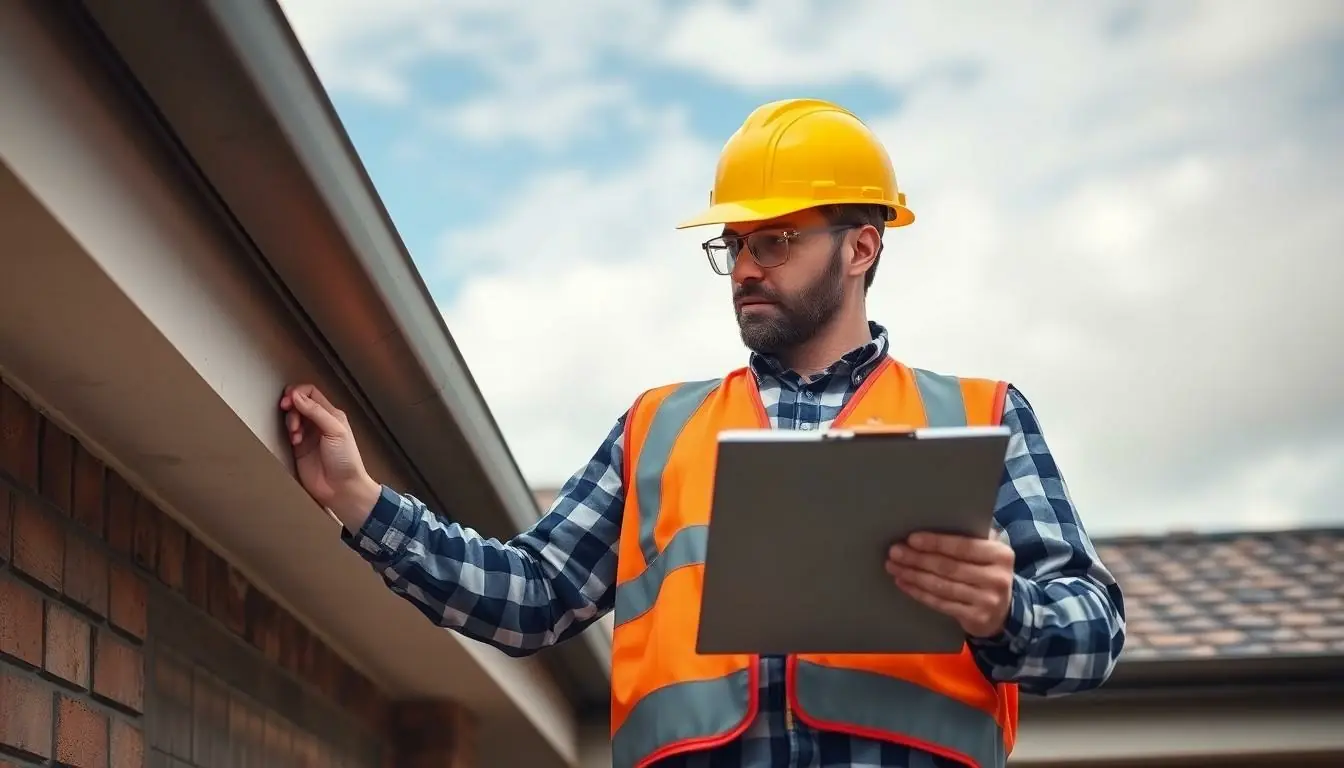In the world of building repair and maintenance, things can get a bit hairy—like a cat stuck in a tree. But fear not! Keeping a building in tip-top shape doesn’t have to feel like a never-ending game of whack-a-mole. With the right approach, it can be as smooth as a fresh coat of paint on a sunny afternoon.
Table of Contents
ToggleOverview of Building Repair and Maintenance
Building repair and maintenance involves systematic processes aimed at ensuring structures remain safe and functional. Regular inspection identifies issues early, reducing potential risks and costs. Implementing a preventive maintenance program plays a key role in extending the lifespan of various components.
Scheduled maintenance tasks often include checking roofs, plumbing, electrical systems, and HVAC units. Each of these systems requires specific attention to detail. For instance, a worn roof surface can lead to leaks, while faulty wiring may pose safety hazards. Repairing these issues promptly avoids more significant damages.
Routine upkeep encompasses both interior and exterior aspects. Painting, cleaning, and replacing worn-out materials enhance aesthetics and functionality. Building owners should focus on high-traffic areas, which tend to show wear more quickly. By prioritizing these sections, they can maintain an appealing environment.
Documentation of repairs and maintenance provides valuable insights into a building’s history. Tracking past work not only aids in current assessments but also assists in future planning. Engaging professionals ensures high standards and compliance with regulations. Qualified technicians offer expertise that enhances safety and performance.
Investment in building repair and maintenance yields long-term benefits. Enhanced property value, reduced emergency repair costs, and improved tenant satisfaction are just a few advantages. Emphasizing a proactive approach helps negate the chaos often associated with neglect.
Importance of Regular Maintenance

Regular maintenance is crucial for preserving a building’s safety and functionality. Adopting a consistent maintenance schedule minimizes risks and enhances overall performance.
Safety Considerations
Identifying hazards early contributes significantly to safety. Regular inspections of structural integrity, electrical systems, and fire safety equipment ensure compliance with safety regulations. Addressing potential issues promptly prevents accidents, protecting occupants from harm. For instance, maintaining fire alarms and extinguishers mitigates risks during emergencies. Furthermore, ensuring proper ventilation in HVAC systems supports air quality. Routine checks help prevent mold and allergens, contributing to a healthier environment for everyone.
Longevity of Structures
Proactive maintenance extends the lifespan of various building components. Regularly checking roofs, plumbing, and electrical systems reduces wear over time. For example, inspecting a roof bi-annually can prevent costly leaks and structural damage. Each repair or replacement prolongs the life of systems, ensuring optimal performance for years to come. Routine upkeep also enhances aesthetic appeal, promoting better tenant experiences. Investing in quality materials during repairs leads to greater durability, significantly decreasing long-term costs. Non-neglected properties retain higher value, attracting potential buyers and tenants alike.
Common Building Repair Issues
Various building repair issues frequently arise, impacting safety and functionality. Addressing these concerns promptly ensures longevity and efficiency.
Roof Problems
Roof problems commonly arise from leaks, missing shingles, or water pooling. Leaks can develop due to wear from weather conditions or improper installation. Regular inspections help identify weak spots early, enabling quick repairs before damage escalates. Missing shingles compromise waterproofing, leading to potential structural damage. Pooling water creates pressure that can deteriorate roofing materials. Implementing a routine inspection schedule mitigates these risks and extends roof lifespan.
Plumbing Issues
Plumbing issues often involve leaks, clogs, and pipe corrosion. Leaks can escalate water bills and result in structural damage if left unattended. Clogs typically occur in drains from debris accumulation, hindering water flow. Pipe corrosion may release contaminants into the water supply, impacting health. Regular maintenance, such as drain cleaning and pipe inspections, addresses these problems effectively. Scheduling prompt repairs prevents minor issues from turning into costly emergency situations.
Electrical Repairs
Electrical repairs include malfunctioning outlets, tripped breakers, and flickering lights. Faulty wiring poses safety risks, increasing the likelihood of electrical fires. Tripped breakers may indicate overloads that require attention. Flickering lights often signal wiring issues or loose connections, needing immediate inspection. It’s essential to hire licensed electricians for these repairs to ensure compliance with safety regulations. Regular check-ups of electrical systems help maintain optimal performance and prevent dangerous failures.
Best Practices for Building Maintenance
Effective building maintenance relies on systematic strategies to preserve safety and functionality. Implementing best practices minimizes risks and enhances the performance of structures.
Scheduled Inspections
Regular inspections serve as a cornerstone of effective building maintenance. Establishing a schedule ensures crucial systems like roofs, plumbing, and electrical components are checked consistently. Inspectors identify potential hazards and initiate timely repairs before they escalate. Documenting findings during these inspections allows for informed decision-making regarding future maintenance plans. Engaging licensed professionals enhances compliance with safety regulations, providing reassurance that all potential issues are addressed. Understanding that consistent attention to details like structural integrity fosters a safer environment for occupants is essential.
Preventative Measures
Focus on preventative measures to extend the life of building components. Regularly servicing HVAC units, checking for leaks in plumbing, and maintaining electrical systems contribute significantly to overall building health. Utilizing high-quality materials during repairs enhances durability, reducing the frequency of future issues. Scheduling routine tasks—such as cleaning gutters, painting, and inspecting fire safety equipment—further protects against deterioration. Proactive maintenance not only preserves aesthetics but also positively impacts tenant satisfaction and retention. Prioritizing these actions ultimately leads to reduced emergency repair costs and improved property value.
Choosing the Right Professionals
Identifying suitable professionals for building repair and maintenance plays a critical role in safeguarding a property’s integrity. First, verify qualifications and certifications to ensure compliance with industry standards. Engaging licensed technicians provides assurance of their expertise, particularly for complex issues like electrical or plumbing repairs.
Next, prioritize experience within the specific field. Veteran professionals are more likely to solve problems effectively and efficiently. They often possess insight into common issues and their solutions, often leading to faster project completion.
Consider obtaining multiple quotes from different contractors before making decisions. This practice fosters competitive pricing and provides options for various budgets.
Read customer reviews and testimonials when evaluating potential hires. Positive feedback often indicates reliability and a history of delivering quality work. A thorough background check can also uncover past performance and any potential red flags.
Request references from previous clients to gauge satisfaction levels. Speaking directly with past customers offers valuable insights into a contractor’s work ethic and professionalism. Often, satisfied clients can reveal essential details about the work process and results.
After narrowing down candidates, hold interviews to assess compatibility and understanding of project requirements. Clear communication during this step aids in establishing expectations. Establishing rapport with professionals leads to smoother collaboration throughout the project duration.
Lastly, review contracts carefully to ensure all details are included. This scrutiny guarantees transparency regarding project scope, timelines, and costs. Understanding terms before projects begin mitigates future conflicts and fosters a productive working relationship.
Building repair and maintenance isn’t just about fixing problems; it’s about creating a safe and functional environment. By implementing a proactive maintenance strategy and conducting regular inspections, property owners can significantly reduce risks and costs. Engaging qualified professionals ensures that all repairs meet industry standards, enhancing the building’s longevity and aesthetic appeal.
Investing time and resources into routine upkeep and preventive measures pays off in the long run. It fosters tenant satisfaction and increases property value. Ultimately, a well-maintained building not only stands the test of time but also reflects a commitment to safety and quality.





